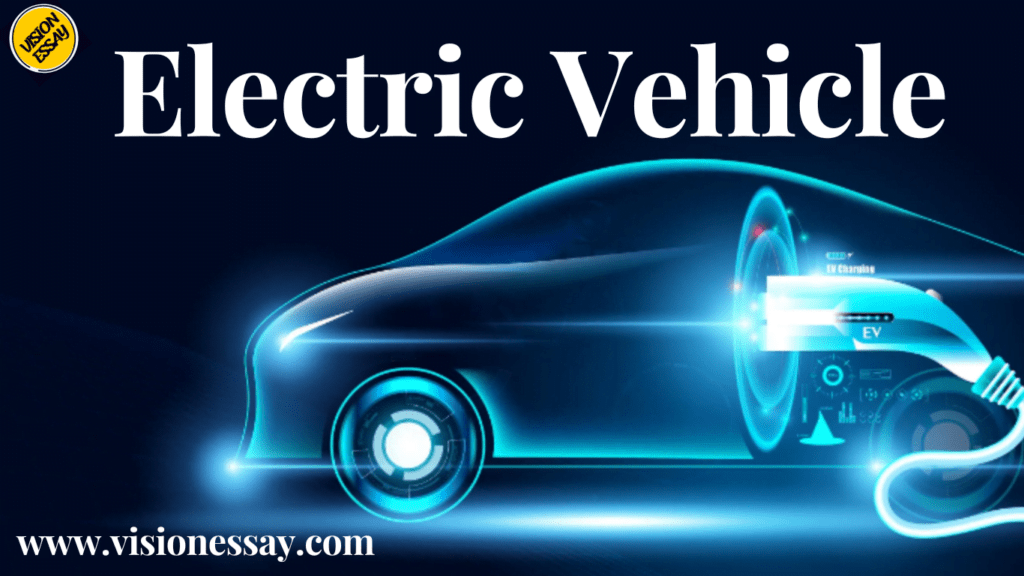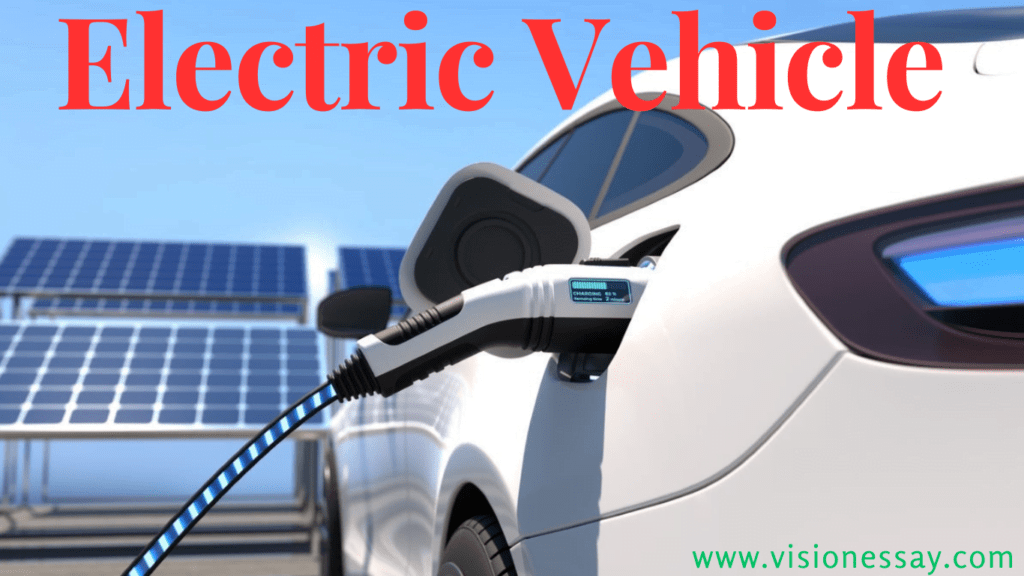
Introduction
Electric vehicles (EVs) have become progressively well known overall as individuals try to diminish their carbon impression and safeguard the climate. Electric Vehicles as a method to reduce carbon emissions and improve environmental conditions. Electric Vehicles decrease the country’s reliance on petroleum derivatives and check contamination.
What is Electric Vehicle
- An electric automobile (EV) is a type of vehicle where the need for an electric engine driven by battery-powered batteries increases suddenly as opposed to a typical gas-powered motor where demand for gasoline or diesel fuel jumps suddenly.
- The two types of electric vehicles are fully electric, which means they only use electricity, and half-breed, which means they include an electrically powered engine and a petrol-controlled motor.
- An electric vehicle’s batteries can be charged using energy from a variety of sources, including conventional power plants, renewable energies like wind and solar energy, or at-home charging stations.
- Recently, electric vehicles have become more popular due to their decreased emissions from fossil fuels and potential savings on maintenance and fuel costs.
- An electric vehicle (EV) is a type of vehicle where demand for an electric engine managed by battery-powered batteries increases suddenly as opposed to a normal gas-powered motor where demand for gasoline or diesel fuel spikes suddenly.
- Due to their decreased emissions of byproducts from fossil fuels and anticipated cost savings on gasoline and maintenance, electric vehicles have recently grown in popularity.
Benefits of Electric Vehicles
Electric vehicles (EVs) are becoming increasingly important as the world seeks to reduce its dependence on fossil fuels and address the issue of climate change.
1. Environmental Benefits
- Due to their much lower greenhouse gas emissions compared to conventional gasoline-powered cars, electric vehicles help to lessen the effects of climate change. Additionally, they lessen urban air pollution, which has major positive health effects.
- When compared to conventional vehicles powered by gasoline or diesel, electric vehicles emit substantially less carbon dioxide and other dangerous pollutants, which reduces air pollution and emissions of greenhouse gases. This is crucial for reducing greenhouse gas emissions and enhancing urban air quality.
2. Technological Innovation
- New battery and charging facilities are being developed as a result of electric vehicle innovations in the automotive industry. This advancement is making electric vehicles more dependable and efficient, which will hasten their acceptance.
- Significant technological advancements in fields like battery innovation, charging infrastructure, and automobile design have resulted from the development of electric cars, and these advancements have the potential to further the sustainability and energy efficiency of society.
3. Improved Public Health
- By lowering the production of pollutants that can lead to respiratory disorders, coronary heart disease, and other problems with health, electric automobiles can also assist to enhance public health.
- As fewer harmful emissions are produced by electric vehicles, this can benefit public health by lowering the risk of lung and other ailments brought on by air pollution.
4. Energy Security
- Electric cars can lessen a nation’s reliance on imported oil and improve energy security. A range of energy sources, including domestically produced renewable energy sources like solar and wind power, can be used to generate electricity.
- Because the batteries that power them may be charged during daylight hours and then drained during periods of high energy demand, electric automobiles can also be utilized as a type of energy storage. This may lessen the need for pricey peaking plants and assist in balancing the grid.
5. Cost Saving
- Electric vehicles can help owners save money over time on fuel, upkeep, and repairs. Since electric automobiles have fewer components that move than conventional cars, they require less servicing and cost less to fix.
- Since the cost of electrical power per mile is frequently less compared to the price of diesel or petrol fuel per mile, electric automobiles typically have lower fuel expenses than conventional gasoline or diesel vehicles. Drivers may experience large savings as a result, especially if they frequently travel long distances or use a lot of fuel.
6. Energy Efficiency
- Compared to cars with internal combustion engines, EVs are significantly more energy-efficient, which means they use less energy to go the same distance. Customers may pay less for energy as a result, and their reliance on fossil fuels may decline.
- Electric automobiles use a lot less energy than cars that run on petroleum. Only 20% of the energy held in gasoline is converted into mechanical energy by gasoline engines, which are used to turn the wheels. In comparison, the conversion of the electrical energy stored in an electric vehicle’s battery towards mechanical energy to drive the wheels is up to 80% efficient.

Challenges Faced in the Adoption of Electric Vehicles
1. High Cost
- With 63% of consumers assuming that an electric car is above their price range, the price has always been a significant deciding factor in the purchase of an electric vehicle.
- Even now, the cost of electric automobiles is higher than that of gasoline-powered ones. Even if battery prices have decreased recently, the total expense of electric cars is still greater than that of conventional automobiles.
2. Charging Infrastructure
- In comparison to conventional fueling stations, electric vehicle charging stations are more difficult to find. This is typically due to high investment costs and challenging infrastructure construction.
- In many places, there is currently a dearth of infrastructure for charging electric vehicles. Even though there are more charging stations than there are gas stations, the ratio is still much different.
3. Charging Time
- One of the biggest problems with electric cars is how long they take to charge. For some buyers, the fact that charging an electric car takes a lot longer than topping up a powered-by-gasoline vehicle can be a deterrent. An electric vehicle can take anything from 30 minutes to a few hours to be fully charged, even with fast charging.
- Electric vehicles have a lengthy charging period due to a number of issues. The battery’s capacity is one of the key elements. Longer charging times are associated with larger batteries. The charging technique utilized has an impact on charging time as well.
4. Limited Range
- The short driving range of electric cars is one of their main drawbacks. The range of the majority of electric vehicles is much less than that of conventional gasoline-powered vehicles, ranging from 100 to 300 miles on a single charge.
- The size and weight of the batteries, the effectiveness of the electric motor, and the road conditions are some of the elements that affect limited-range electric vehicles. The main issue impacting range is batteries, and as battery size increases, it also increases weight, which can reduce a vehicle’s efficiency and range.
5. Consumer Awareness
- The advantages of electric automobiles, such as cheaper running costs, lesser pollutants, and better performance, are still largely unknown to customers. One of the biggest challenges facing the business is to inform consumers about the advantages of electric vehicles.
- One obstacle to the widespread use of electric vehicles is consumer awareness. The advantages of electric automobiles, such as cheaper running costs, lesser pollutants, and better performance, are still largely unknown to customers. Lack of knowledge can make it challenging for consumers to make educated judgments when buying a car and can prevent the use of electric vehicles.
What should India’s adoption strategy for EVs be going forward?
- By giving both consumers and manufacturers subsidies, tax breaks, and financing options, we can lower the initial cost of purchasing an EV.
- Encourage innovation, rivalry, and cooperation among original equipment manufacturers (OEMs), start-ups, and other stakeholders to broaden the selection of EVs.
- Through incentives and helpful policies, promote domestic production of EVs and associated parts.
- Launch campaigns, sites, and platforms to inform the public about the advantages and incentives of EVs in order to increase awareness among them.
- By making investments in renewable energy sources, smart grids, and energy storage devices, we can increase the supply and distribution of electricity.
- By creating fast charging and battery-swapping standards and technology, EV charging times can be shortened.
- By building a nationwide network of high-quality, easily accessible public and private charging stations, the EV infrastructure may be expanded.
- By educating and accrediting experts, mechanics, and dealers on EV maintenance and servicing, we can improve the service centers and repair alternatives for EVs.
Conclusion
Electric vehicles are becoming increasingly popular as they offer a cleaner and more sustainable mode of transportation compared to traditional gasoline-powered vehicles. They emit less harmful pollutants and greenhouse gases, which can help mitigate the impacts of climate change. However, there are still several issues with electric vehicles, including their short driving range, greater initial costs, and the scarcity of infrastructure for charging in some locations. Nevertheless, the advantages of electric vehicles exceed these drawbacks, and they are anticipated to be considerably more common in the future as advancements in technology and sustainability gain importance.
Frequently Asked Questions (FAQs)
What are the advantages and challenges of electric vehicles?
Electric cars provide advantages for the environment, lower running costs, better performance, and less noise pollution. Range anxiety, upfront costs, charging times, and a limited operating range are drawbacks.
What are the challenges of EVs in India?
1. Lack of Clean Energy. Much of India’s electricity is generated from burning coal.
2. Underdeveloped Charging Infrastructure. Infrastructural issues stand against India’s quest for full EV adoption.
3. Suboptimal Battery Technology.
4. Persistent Resistance to Change.What is the impact of electric vehicles?
Environmental Advantages of Electric Vehicles | EV & Petrol Vehicles | EDF
benefits for the environment with electric vehicles. According to research, electric vehicles are more environmentally friendly. Compared to gasoline or diesel automobiles, they release fewer greenhouse gases and air pollutants. Additionally, this accounts for the power needed to maintain them during manufacturing.What is the future of electric vehicles?
As sales of electric vehicles surpassed 10 million in 2022, their marketplaces are expanding exponentially. From 4% in 2020 to 14% in 2022, the proportion of electric vehicles in overall sales has more than quadrupled in only three years. Sales of EVs are anticipated to remain robust through 2023.
Sources:
- Trends and developments in electric vehicle markets – Global EV Outlook 2021 – Analysis – IEA
- Growth Sector: Electric Vehicles Sales And The New Electric Economy Have Arrived (forbes.com)
- Charging into the future: the transition to electric vehicles : Beyond the Numbers: U.S. Bureau of Labor Statistics (bls.gov)
- The rise of electric vehicles—2020 status and future expectations – NASA/ADS (harvard.edu)
- https://www.thehindu.com/news/national/karnataka/93-growth-in-electric-vehicle-charging-infrastructure-in-2022-compared-to-a-year-ago-says-niti-aayog-member/article65923611.ece
